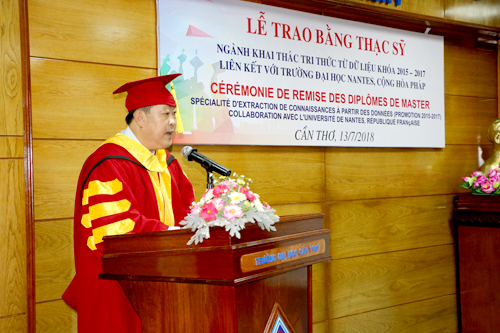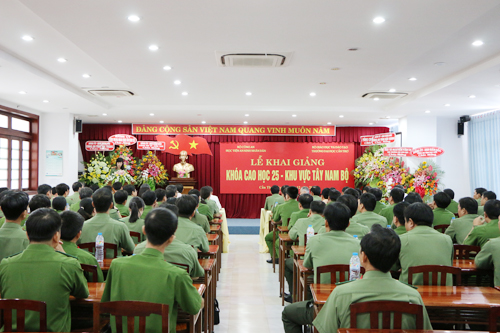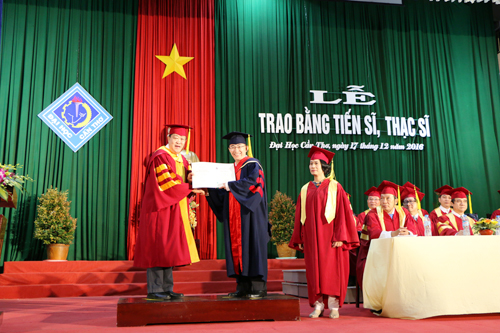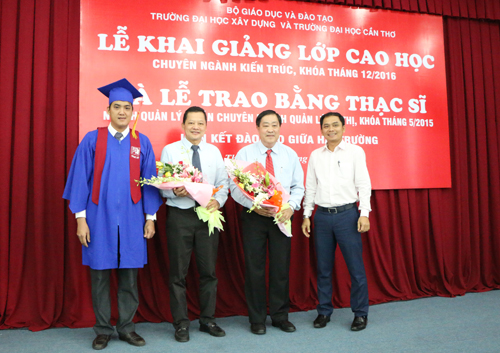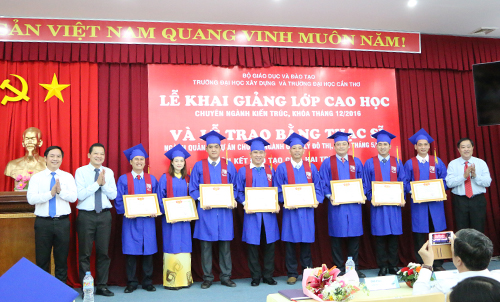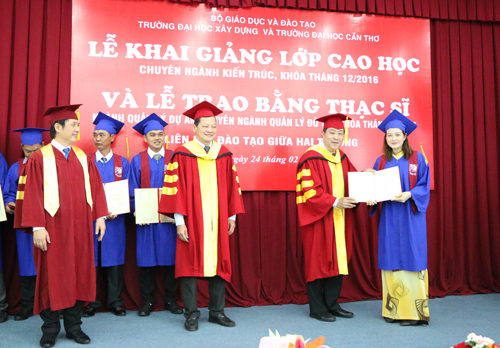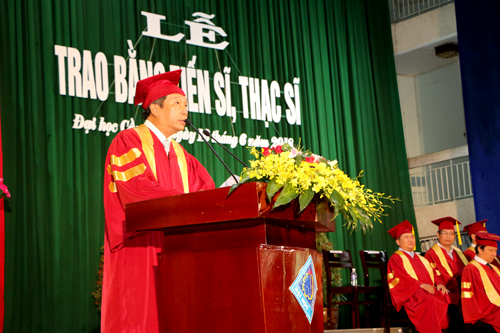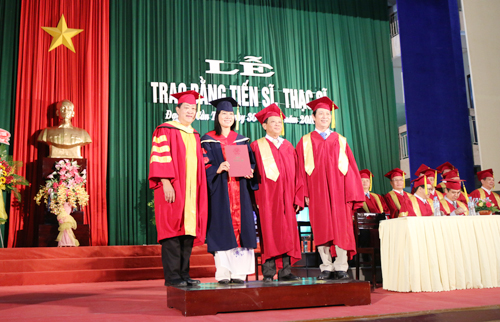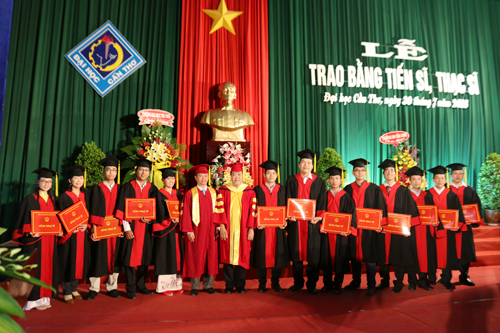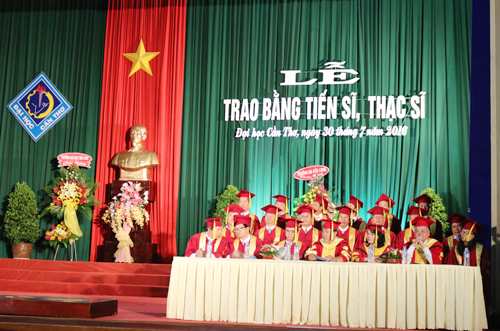
Tên đề tài: “Nghiên cứu môi trường đất, nước và đa dạng cá của các mô hình sản xuất tại U Minh Hạ - tỉnh Cà Mau”.
Tác giả: Lê Văn Dũ, Khóa: 2017
Chuyên ngành: Môi trường đất và nước ; Mã số: 62440303. Nhóm ngành: Khoa học tự nhiên.
Người hướng dẫn chính: PGS.TS. Trương Hoàng Đan - Trường Đại học Cần Thơ.
- 1. Tóm tắt nội dung luận án
Tràm trồng và đặc biệt là canh tác Keo lai sẽ mang lại lợi nhuận cao gấp 3 đến 4 lần so với Tràm bản địa; đã đặt ra nhiều thách thức về mức độ xáo trộn hiện trạng đất mặt tự nhiên do kỹ thuật đào liếp trồng trên vùng đất phèn (phèn tiềm tàng được đào đưa lên bề mặt sinh ra phèn hoạt động). Tăng qui mô trồng Tràm và Keo lai có thể làm tăng quá trình sinh phèn, phóng thích nhiều độc tố như sulfate (SO42-), nhôm (Al3+), sắt (Fe2+) vào trong môi trường gây ô nhiễm nước và ảnh hưởng đến đa dạng sinh học, đặc biệt là cá. Vì vậy, nghiên cứu về tác động của mô hình canh tác Keo lai, Tràm trồng và Lúa 2 vụ đến chất lượng môi trường đất, nước và đa dạng cá tại U Minh Hạ - tỉnh Cà Mau là cần thiết nhằm cung cấp thông tin khoa học về mối tương quan chính giữa đặc tính môi trường đất, nước, và đa dạng cá để đưa ra giải pháp phù hợp cho công tác quản lý VQG U Minh Hạ.
Nghiên cứu tiến hành khảo sát thực địa 6 chỉ tiêu đất, 9 chỉ tiêu nước, và thành phần loài cá tự nhiên trên đất phèn nông và phèn sâu, vào mùa khô và mùa mưa, với cấp tuổi khác nhau ở đợt 1 (tháng 9/2018) và đợt 2 (tháng 2/2019) trên các mô hình Tràm tự nhiên, Tràm trồng, Keo lai và lúa 2 vụ. Số liệu thu thập được xử lý thống kê đa biến với kết quả như sau:
Mô hình trồng Keo lai có độ cao liếp là 0,9 m và mương rộng 4,6 m, đối với mô hình tràm trồng có kích thước (cao 0,6 m và rộng 3,6 m). Vìệc đào mương sâu và rộng để canh tác cho thấy khả năng đào liếp đưa tầng đất phèn tiềm tàng lên mặt liếp là rất cao, xảy ra quá trình quang hóa, phóng thích và lan truyền chất độc hại vào môi trường nước nhiều, gây ảnh hưởng đến phát triển thủy sinh vật, đặc biệt là nguồn cá tự nhiên.
Đối với chất lượng đất tại khu vực nghiên cứu, việc phân tích tương quan các chỉ tiêu chất lượng đất cho thấy sự xáo trộn đất ở khu vực Tràm trồng và Keo lai ảnh hưởng nhiều đến sự thay đổi đặc tính đất so với hai mô hình còn lại. Phân tích cụm chứng minh được sự tương đồng chất lượng đất của Tràm trồng và Keo lai; trong khi mô hình Tràm tự nhiên là một cụm riêng biệt. Kết quả phân tích PCA đã chỉ ra hai PCs gây ra sự biến động chính chất lượng đất tầng phèn nông với tỉ lệ (73,21%) và phèn sâu là (83,47%). Trong khi đó, biến động chất lượng đất theo mùa phức tạp hơn với bốn PCs xác định khoảng 93,53% biến động vào mùa khô và 96,08% vào mùa mưa. Các thông số quan trọng nhất trong việc phân biệt chất lượng đất giữa hai tầng chủ yếu là pH, tỷ trọng, chất hữu cơ và TP; Các yếu tố tỷ trọng và ẩm độ có ý nghĩa phân biệt chất lượng đất giữa mùa mưa và mùa khô.
Đối với chất lượng nước, thông số hữu cơ (BOD và COD) và dinh dưỡng (N-NO₃ˉ và N-NH₄⁺) ở tất cả các mô hình đều vượt ngưỡng quy định bảo tồn động thực vật thuỷ sinh. Chất lượng nước thuộc tầng đất phèn nông ô nhiễm hữu cơ nhiều hơn hơn so với đất phèn sâu. Dinh dưỡng thay đổi theo mô hình canh tác, cao ở Tràm tự nhiên, sau đó giảm dần là Keo lai và Tràm trồng. Mức độ ô nhiễm môi trường nước cũng có sự thay đổi theo mùa, mùa mưa ô nhiễm nặng hơn mùa khô. Phân tích PCA cho thấy chất lượng nước bị tác động chủ yếu bởi các quá trình tự nhiên giữa hai mùa, đặc biệt là tác động quá trình oxy hoá trong đất phèn. Các PCs xác định khoảng 83,03% sự biến động chất lượng nước ở đất phèn nông và 84,15% ở phèn sâu; 74,49% (mùa khô) và 77,50% (mùa mưa). Phân tích DA cho thấy pH, EC, BOD, COD, N-NH₄⁺, N-NO₃ˉ và Fe³⁺ là quan trọng đối với chất lượng nước giữa hai mùa; trong khi đó, giữa hai tầng phèn, các thông số quan trọng được ghi nhận là pH, EC, DO, COD và N-NH₄⁺.
Phân tích tương quan ghi nhận các thông số môi trường đất và nước có mối liên hệ chặt chẽ, thứ tự được sắp xếp như sau Tràm tự nhiên > Tràm trồng = Keo lai > Lúa hai vụ.
Đa dạng thành phần loài cá tại các mô hình được ghi nhận có sự suy giảm, thuỷ vực thuộc phèn nông đa dạng kém hơn so với phèn sâu. Tràm tự nhiên có cấu trúc thành phần loài thấp hơn Keo lai, Tràm trồng và Lúa hai vụ. Phân tích BIO-ENV cho thấy đa dạng thành phần loài cá trong mô hình Keo lai tương quan với 7 thông số (pH, EC, BOD, N-NO₃ˉ, N-NH₄⁺, Fe³⁺ và Al³⁺), thông số pH có ý nghĩa nhất. Trong khi, mô hình Tràm trồng chất lượng nước không có tác động đáng kể đến da dạng cá.
Liên quan đến giải pháp quản lý, việc đào mương lên liếp sẽ dẫn đến độc chất vì vậy cần giữ lớp đất mặt, bón vôi để hạn chế phèn tiềm tàng; Thường xuyên vệ sinh liếp, mương, thu gom xác bã thực vật định kỳ, tránh tích tụ vật rụng; Trồng thủy sinh thực vật ven bờ để lọc nước, chú ý thu hoạch sinh khối để hạn chế phú dưỡng; Trồng luân phiên Tràm và Keo lai theo 2 chu kỳ liên tục (8 -10 năm) để cải thiện chất lượng đất, nước từ khả năng cố định đạm của Keo lai, sự thông thoáng kênh mương ở mô hình Keo lai cũng góp phần cải tạo chất lượng nước cho sự phát triển của thủy sinh vật, trong đó có cá. Đa dạng hóa sinh kế cho người dân nhằm hạn chế hoạt động đánh bắt cá và hoạt động trồng Keo lai. Mô hình nuôi cá sặc rằn (thuộc bộ cá vược) được khuyến cáo vì tính thích nghi tốt của loại cá này cho khu vực tràm trồng và canh tác Keo lai.
- 2. Những kết quả mới của luận án:
Điểm mới của luận án là tập trung sử dụng các phương pháp, kỹ thuật xử lý thống kê để suy luận, tìm ra mối liên hệ giữa các kiểu sử dụng đất (lên liếp trồng Keo lai và Tràm trồng) đến môi trường nước. Đồng thời các nhân tố chính ảnh hưởng đến chất lượng môi trường đất, nước cũng được nhận biết nhờ vào việc ứng dụng các phương pháp này. Với phương pháp phân tích biệt số được sử dụng để nhận biết chỉ tiêu chính ảnh hưởng đến môi trường đất theo tầng phèn bao gồm: pH, tỷ trọng, CHC và TP. Các chỉ tiêu chính ảnh hưởng đến môi trường nước là pH, EC, DO, COD và N-NH₄⁺. Như vậy pH là nhân tố quan trọng làm biến động chất lượng môi trường ở các mô hình. Phương pháp phân tích thành phần chính (PCA) sẽ giúp nhận biết các nguồn gây ra tác động đến chất lượng môi trường nước; với 2 PCs gây biến động chất lượng nước theo tầng phèn và 4 PCs theo mùa;
Bio-Env là phương pháp hiệu quả để xác định rõ yếu tố quan trọng ảnh hưởng đến đa dạng cá với các chỉ tiêu chất lượng nước pH, EC, BOD, N-NO₃ˉ, N-NH₄⁺, Fe³⁺ và Al³⁺. Vì vậy, có thể dựa vào kết quả đề tài để đưa ra các giải pháp quản lý phù hợp về môi trường đất, nước và cá tại vùng nghiên cứu;
Bên cạnh đó chất lượng môi trường đất, nước ở các mô hình sản xuất khá biến động. Xu hướng ở mô hình lúa 2 vụ và Tràm tự nhiên thì hàm lượng chất hữu cơ, đạm và lân cao hơn so với mô hình Tràm trồng và Keo lai. Điều này cho thấy ở mô hình sản xuất bị tác động thì chất lượng môi trường sẽ bị suy giảm, vì vậy cần phải có giải pháp quản lý phù hợp để đảm bảo chất lượng môi trường đất, nước, từ đó đảm bào chất lượng môi trường sống cho cá;
Nghiên cứu đã chỉ ra, tại khu vực Tràm trồng và Keo lai, bộ cá Vược và cá Chép chiếm ưu thế, cho thấy đây là loại cá thích nghi với điều kiện môi trường bị tác động, cần nghiên cứu tiếp tục để tạo mô hình sinh kế phù hợp cho vùng nghiên cứu.
- 3. Các ứng dụng/khả năng ứng dụng trong thực tiễn, các vấn đề tiếp tục nghiên cứu:
3.1 Ý nghĩa khoa học
Nghiên cứu đã sử dụng phương pháp khảo sát thực địa kết hợp với phân tích thống kê đa biến xác định được hiện trạng canh tác Keo lai, Tràm, lúa hai vụ theo độ sâu tầng phèn đến môi trường đất, nước và đa dạng cá tại vùng đệm vườn quốc gia U Minh Hạ, tỉnh Cà Mau. Kết quả nghiên cứu cung cấp thông tin khoa học về mối quan hệ giữa kiểu sử dụng đất, các vấn đề môi trường tác động đến đa dạng cá thông qua các nhân tố nhân tố chính, phân tích tác động và nguyên nhân ảnh hưởng đến chất lượng đất, nước. Kết quả nghiên cứu này sẽ làm tài liệu tham khảo hay cơ sở khoa học cho các nghiên cứu tiếp theo trong lĩnh vực quản lý chất lượng môi trường, bảo vệ nguồn lợi cá và các lĩnh vực liên quan khác.
3.2 Ý nghĩa thực tiễn
Việc chuyển đổi mô hình canh tác có thể dẫn đến các tác động môi trường và đa dạng sinh học. Nghiên cứu này đã xác định hoạt động chuyển đất tự nhiên sang đất liếp trồng Keo lai và Tràm trồng dẫn đến thay đổi tính chất đất và nước từ đó góp phần tác động đến đa dạng cá. Từ ý nghĩa trên cho thấy thực tiễn nhu cầu phát triển kinh tế rừng đã được qui hoạch nên cần thiết ưu tiên trồng Tràm, hạn chế trồng Keo lai, hoặc thay đổi luân phiên chu kỳ sử dụng đất giữa Tràm trồng và Keo lai để hạn chế tối thiểu tác động đến môi trường nước và đa dạng cá tại vùng đệm VQG U Minh Hạ, tỉnh Cà Mau. Kết quả này có thể sử dụng vào thực tiễn quản lý, phát triển bền vững vùng đệm vườn quốc gia U Minh Hạ và các khu bảo tồn có vùng đệm có tính chất tương tự. Ngoài ra, kết quả nghiên cứu còn phục vụ hiệu quả cho việc lựa chọn yếu tố môi trường đưa vào quan trắc định kỳ tại các kiểu sử dụng đất như lên liếp trồng Keo lai, trồng Tràm và Lúa hai vụ.
3.3 Các vấn đề cần tiếp tục nghiên cứu
Nghiên cứu kỹ thuật đào liếp trồng Tràm và Keo lai: giữ lại lớp đất mặt để phủ lên mặt liếp trồng nhằm ngăn phèn phát sinh từ thân liếp.
Nghiên cứu, đánh giá chất lượng đất và nước, thành phần cá theo đề xuất trồng luân phiên Tràm và Keo lai theo chu kỳ 8 – 10 năm (cần có chính sách bắt buộc trong hợp đồng giao khoán đất rừng để đảm bảo mô hình tồn tại trong thực tế).
Nghiên cứu về trữ lượng cá, tốc độ tái sinh, từ đó tính toán số lượng từng loại cá cho phép đánh bắt để khôi phục sản lượng cá tự nhiên trong khu vực nghiên cứu.
Định kỳ quan trắc chất lượng môi trường đất, nước đảm bảo công tác quản lý phát triển bền vững VQG U Minh Hạ.
Name of thesis: Research on soil, water enviromnet and fish diversity of production models in U Minh Ha - Ca Mau
Field of study: Soil and Water environment
Code: 62440303
Full name of student: Le Van Du
Scientific supervisor: Assoc. Prof. Dr. Truong Hoang Dan
Educational institution: Can Tho University
- Summary
With the profit of planted Melaleuca, especially Acacia hybrid, being three to four times that of native Melaleuca, there are many challenges in terms of the degree of disturbance of the natural ground/soil condition caused by the cultivation technique on acid sulfate soils layer. To generate an active acid sulfate soil, the potential is excavated and brought to the surface. Increasing the scale of Melaleuca and Acacia hybrids can increase the acid sulfate production process, releasing many toxins into the environment such as sulfate (SO42-), aluminum (Al3+), and iron (Fe2+), causing water pollution and negatively affecting the environment, biodiversity, particularly fish. To provide scientific information on the interrelationship, research on the impact of Acacia hybrid and planted Melaleuca models and remain models on the quality of soil, water, and fish diversity in U Minh Ha - Ca Mau province is required. The key relationship between soil, water, and fish diversity in order to provide suitable solutions for U Minh Ha National Park management.
Conduct a field survey of 6 soil parameters, 9 water parameters, and natural fish species composition on shallow and deep acid sulfate soils, dry and rainy seasons, and different age levels of tree, in phase 1 (September 2018) and phase 2 (February 2019) on models of Natural Melaleuca, planted Melaleuca, Acacia hybrid, and 2-crop rice. The collected data were analyzed using multivariate statistics, and results achived as following results:
The raise bed (0.9 m in high) and ditch (4.6 in wide) in the Acacia hybrid model are more than that to planted Melaleuca (0.6m; 3.6m). As a result, a deeper and wider ditches are required to plant Acacia hybrid, demonstrating that the ability to dig up the potential acid sulfate soil layer to the surface/topsoil is very high, photochemical processes and the release and discharge of acid sulfate occur in the soil, water environment, affecting the development of aquatic organisms and natural fish.
Correlation analysis of soil quality indicators confirms that soil disturbance affects soil characteristics and changes the relationship between indicators more in Melaleuca and Acacia hybrid models than in the other two models. Cluster analysis shows that the soil quality of planted Melaleuca and Acacia hybrid model is similar, while the natural Melaleuca model is in its own cluster. The PCA analysis revealed that two PCs were responsible for the majority of the variation in soil quality of shallow acid sulfate soil layer (73.21 percent) and deep acid sulfate soil layer (73.21 percent) (83.47 percent). Meanwhile, seasonal variation in soil quality is more complex, with four PCs identifying approximately 93.53 percent of the variation in the dry season and 96.08 percent of the variation in the rainy season, with the remaining variation in natural physicochemical processes, soil characteristics, fertilizer application, and hydrological factors. The most important parameters in separating soil quality between the two acid sulfate soil layers are pH, density, organic matter, and TP (Total phosphorous); density and moisture are important in differentiating soil quality between the rainy and dry seasons.
Organic parameters (BOD and COD) and nutrients (N-NO₃ˉ và N-NH₄⁺) exceeded the thresholds for aquatic flora and fauna conservation in all models. Water quality in shallow acid sulfate soil layer is worse than in deep one, with organic and nutrient pollution being the worst in the natural Melaleuca model, followed by Acacia hybrid and cultivated Melaleuca. The differences in BOD, COD, N-NO₃ˉ and N-NH₄⁺ parameters have revealed that water quality is affected by season, with pollution being more severe during the rainy season. According to Principal component analysis (PCA) analysis, water quality is primarily influenced by natural processes that occur between seasons, particularly the effects of oxidation in acid sulfate soils. The Principal component (PCs) detected approximately 83.03 percent of the variation in water quality in shallow acid sulfate soils and 84.15 percent in deep acid soils; 74.49 percent (dry season) and 77.50 percent (wet season). Following Discriminant analysis (DA) analysis, pH, EC, BOD, COD, N-NH₄⁺, N-NO₃ˉ, and Fe³⁺ are important for water quality variation between seasons; meanwhile, pH, EC, DO, COD, and N-NH₄⁺ is important between the two acid sulfate soil layers.
Correlation analysis revealed that soil and water environmental parameters in modles are closely related, in the following order: Planted Melaleuca > Natural Melaleuca = Acacia hybrid > 2-crop rice. The models' diversity of fish species composition was found to be reduced, water bodies in shallow acid sulfate soil layer were less diverse than deep one, and fish species composition in natural Melaleuca model was lower than Acacia hybrid, cultivated Melaleuca, and 2-crop rice. The BIO-ENV analysis showed that fish species diversity in the Acacia hybrid model was correlated with 7 parameters (pH, EC, BOD, N-NO₃ˉ, N-NH₄⁺, Fe³⁺ , and Al³⁺), with pH being the most significant. Meanwhile, water quality in planted Melaleuca model had no effect on the fish composition diversity.
It is proposed to raise Giant gourami (cá sặc rằn) in ditches of long-planted Melaleuca and Acacia hybrid models, with pH ranging from 5 to 7 and remaining stable during the rasing crop. Photosynthetic algae grown from wide, low-coverage ditches in the Acacia hybrid model, and decomposing vegetation/falling objects were food for this fish.
Digging a ditch will lead to toxicity releasing, so it is necessary to keep the topsoil and apply lime to limit potential acid sulfate. Regularly clean raise beds, ditches in production models, collect plant residues periodically to avoid accumulation of fallen objects. To plant aquatic plants along the shore of raise bed to filter water, to pay attention to harvesting biomass in order to limit eutrophication process; and diversify people's livelihoods to limit fishing and Acacia hybrid cultivation.
Planting Melaleuca and Acacia hybrids alternately in two continuous cycles (8-10 years) to improve soil and water quality from Acacia hybrid nitrogen fixation ability; canal ventilation in the Acacia hybrid model also contributes to soil and water quality improvement, improve water quality for the growth of aquatic organisms, including fish.
- The new findings of the thesis
The thesis's new focus is on using statistical processing methods and techniques to find the relationship between land use types (Acacia hybrid and Melaleuca plantations) and the environment. Simultaneously, the main factors influencing the quality of the soil and water environment are identified through the use of these methods. Using the discriminant analysis method, the main criteria affecting the soil environment according to acid sulfate soil layer were identified, including pH, density, CHC, and TP. The main water environment indicators are pH, EC, DO, COD, and N-NH₄⁺. Principal component analysis (PCA) will assist in identifying sources that have an impact on water quality, with two PCs causing water quality fluctuations based on the acid sulfate soil layer and four PCs based on the season;
Bio-Env is an efficient method for identifying important factors influencing fish diversity using water quality parameters such as pH, EC, BOD, N-NO₃ˉ, N-NH₄⁺, Fe³⁺ and Al³⁺. As a result, the study's findings can be used to provide appropriate management solutions for the soil, water, and fish environments in the study area.
Besides, the quality of the soil and water environment in production models varies greatly. The organic matter, nitrogen, and phosphorus content of the 2-crop rice and natural Melaleuca models is higher than that of the cultivated Melaleuca and Acacia hybrid models. This indicates that the environmental quality will be degraded in the affected production model, so an appropriate management solution is required to ensure the quality of the soil and water environment, thereby ensuring the quality of the environment habitat for fish resources;
Research has shown that the orders Perciformes and Cypriniformes are dominant in areas where Melaleuca and Acacia hybrids are grown, indicating that this is a kind of fish that is adapted to the affected environmental conditions and creating a viable livelihood model for the research area.
- 3. Applications/Scientific and practical values of the study, In the future, study problems:
3.1 Scientific values
The study used a field survey method with multivariate statistical analysis to The study used field survey method with multivariate statistical analysis to determine the current status of Acacia hybrid, Melaleuca, and 2-crop rice cultivation according to the depth of acid sulfate soil layer, water and fish diversity in the buffer zone of U Minh Ha National Park, Ca Mau Province. The findings of the study provide scientific information on the relationship between land use types, environmental issues affecting fish diversity through key factors, analysis of impacts and causes affecting fish species, soil and water quality. The results of research will serve as a reference or a scientific basis for further studies in the field of environmental quality management, fish resource protection and other related fields
3.2 Practical values
Changing farming techniques can have an impact on the environment and biodiversity. The conversion of natural land to Acacia hybrid and Melaleuca plantations results in changes in soil and water characteristics, which contribute to the impact on fish diversity in the buffer zone of U Minh Ha National Park in Ca Mau province. However, because the need for forest economic development has been planned, it is necessary to prioritize Melaleuca planting, limit Acacia hybrid planting, or change the land use cycle rotation between planting Melaleuca and Acacia hybrid to minimize the impact on the aquatic environment and fish diversity. This result can be applied to the reality of sustainable management and development of U Minh Ha National Park's buffer zone and other protected areas with similar buffer zones. The findings can also be used to select environmental factors for periodic monitoring in land use types such as Acacia hybrid, Melaleuca, and 2-crop rice.
3.3 Recommended further study
Research on planting techniques for Melaleuca and Acacia hybrids that retain topsoil to cover the planting surface and prevent acid sulfate from arising from the body of raise bed.
Research and evaluate the quality of soil and water, as well as fish composition, in accordance with the proposal of alternate planting of Melaleuca and Acacia hybrids every 8-10 years (a mandatory policy is required in the forest land allocation contraction to ensure the model existing in reality).
Research on fish stocks and regeneration rates is needed. Take in account to amount of each kind of fish that can be caught to restore wild fish production in the study area.
Periodically monitor the quality of soil and water environment to ensure sustainable development management of U Minh Ha National Park.
- Xem chi tiết nội dung luận án
- Xem thông tin đăng tải tại Website Bộ giáo dục và Đào tạo. (Nhập tên NCS vào ô tìm kiếm)





